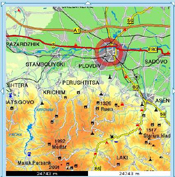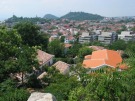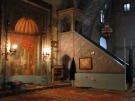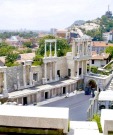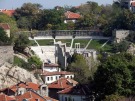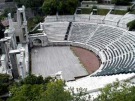Plovdiv
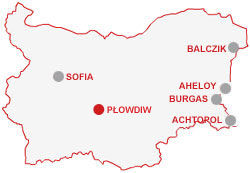 The city of Plovdiv is situated in the western part of the Gornotrakiiska (Upper Thracian) Lowland, along the two banks of Maritsa, the largest river, springing out in Bulgaria, and scattered upon six unique hills (called “tepeta”- hillrocks). The town is located 150 km south-east of Sofia, 270 km west of Bourgas, 140 km north-west of Svilengrad, 58 km south of Karlovo, 19 km north-west of Assenovgrad, 102 km north of Smolyan, 37 km east of the town of Pazardzhik, 90 km south-west of Stara Zagora, 75 km north-west of Haskovo. It ranks as the second Bulgarian city in population, size and significance, after the capital Sofia. The city is an important cultural, historic and tourist centre. It is a regional administrative centre, as well.
The city of Plovdiv is situated in the western part of the Gornotrakiiska (Upper Thracian) Lowland, along the two banks of Maritsa, the largest river, springing out in Bulgaria, and scattered upon six unique hills (called “tepeta”- hillrocks). The town is located 150 km south-east of Sofia, 270 km west of Bourgas, 140 km north-west of Svilengrad, 58 km south of Karlovo, 19 km north-west of Assenovgrad, 102 km north of Smolyan, 37 km east of the town of Pazardzhik, 90 km south-west of Stara Zagora, 75 km north-west of Haskovo. It ranks as the second Bulgarian city in population, size and significance, after the capital Sofia. The city is an important cultural, historic and tourist centre. It is a regional administrative centre, as well. Presently Plovdiv is a very beautiful city, coming from the past and striving forward to its future. The hills of Plovdiv are noticeable from quite a distance. This is an area of a vast flat plain and all of a sudden hills pop up! Besides the three hills already mentioned (Dzhambaz Tepe, Taxim Tepe and Nebet Tepe), around which the ancient town has been founded and which host the most interesting and precious remains of our past, stone breasts are rising Sahat Tepe, also known as the Danov’s Hill (within the centre of the town, with the clock tower dating back to 16th century), Bunardzhika Tepe (west of the city centre, with the stature of a Russian soldier), and Dzhendem Tepe (The hill of Youht, further to the west). The six hills, as well as the old town of Plovdiv bring specific colour and atmosphere to the town and shape up its unique view and nature.
Maritsa River, splitting the city into two uneven parts connected by six bridges, occupies its relevant place and has its significance for the city of Plovdiv. On the area of the smaller, northern part of the city, along the riverbank, the so-called Fair City is located. The first Bulgarian exhibition was organized back in 1892, which later on turned into International Plovdiv Fair. Currently the fair is conducted twice annually - in the beginning of May the fair is dedicated to consumer goods and commodities, while the fair organized in September focuses on industrial goods. Plovdiv is famous as being a centre of rich agricultural area and its numerous marketplaces are exuberant with great variety of cheap fruit and vegetables.
The city plays the role of a big cultural centre. In addition to the regular opera, theatre, Muppet-show and other performances, Plovdiv hosts traditional festivals, art exhibitions, biennials, some of them internationally recognized: June - International Chamber Music Festival, end of May, beginning of June - Opera days at the Amphitheatre, end of June - Verdi Opera days at the Amphitheatre, beginning of August - International Folklore Festival, September - International Muppet-Show Festival, September - “The old town of Plovdiv” National Autumn Art Exhibition. Plovdiv is also a university centre with one university and a couple of higher educational establishments.





